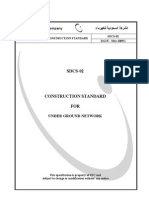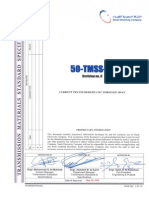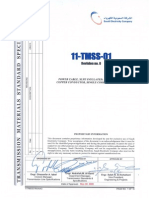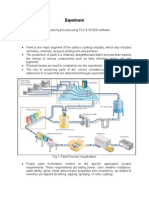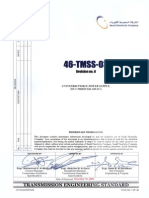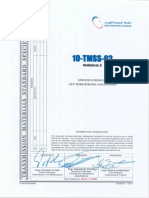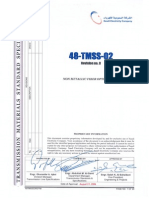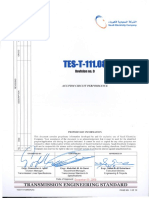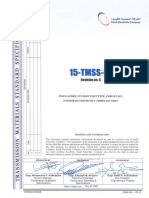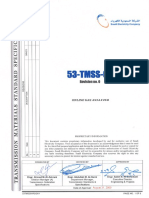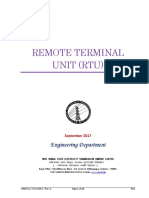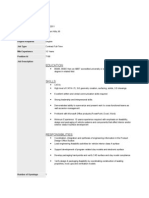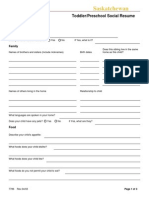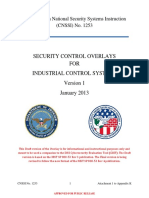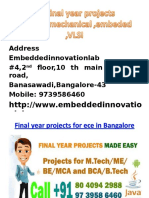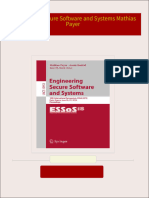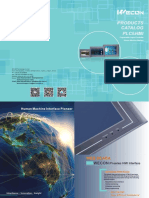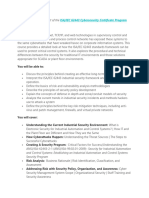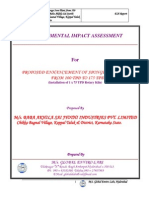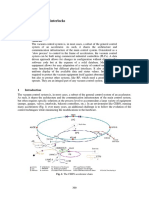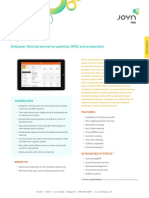0 ratings0% found this document useful (0 votes)
417 views38 TMSS 03 R0
38 TMSS 03 R0
Uploaded by
renjithas2005This document provides specifications for remote terminal units (RTUs) intended for use in Saudi Electricity Company's supervisory control and data acquisition (SCADA) system. It specifies technical requirements for the design, manufacture, and performance of RTUs. The document outlines RTU system design requirements, including modular and distributed architecture, as well as requirements for subsystems, processors, networking, testing, and documentation.
Copyright:
Attribution Non-Commercial (BY-NC)
Available Formats
Download as PDF, TXT or read online from Scribd
38 TMSS 03 R0
38 TMSS 03 R0
Uploaded by
renjithas20050 ratings0% found this document useful (0 votes)
417 views0 pagesThis document provides specifications for remote terminal units (RTUs) intended for use in Saudi Electricity Company's supervisory control and data acquisition (SCADA) system. It specifies technical requirements for the design, manufacture, and performance of RTUs. The document outlines RTU system design requirements, including modular and distributed architecture, as well as requirements for subsystems, processors, networking, testing, and documentation.
Original Description:
electrical
Original Title
38-TMSS-03-R0
Copyright
© Attribution Non-Commercial (BY-NC)
Available Formats
PDF, TXT or read online from Scribd
Share this document
Did you find this document useful?
Is this content inappropriate?
This document provides specifications for remote terminal units (RTUs) intended for use in Saudi Electricity Company's supervisory control and data acquisition (SCADA) system. It specifies technical requirements for the design, manufacture, and performance of RTUs. The document outlines RTU system design requirements, including modular and distributed architecture, as well as requirements for subsystems, processors, networking, testing, and documentation.
Copyright:
Attribution Non-Commercial (BY-NC)
Available Formats
Download as PDF, TXT or read online from Scribd
Download as pdf or txt
0 ratings0% found this document useful (0 votes)
417 views0 pages38 TMSS 03 R0
38 TMSS 03 R0
Uploaded by
renjithas2005This document provides specifications for remote terminal units (RTUs) intended for use in Saudi Electricity Company's supervisory control and data acquisition (SCADA) system. It specifies technical requirements for the design, manufacture, and performance of RTUs. The document outlines RTU system design requirements, including modular and distributed architecture, as well as requirements for subsystems, processors, networking, testing, and documentation.
Copyright:
Attribution Non-Commercial (BY-NC)
Available Formats
Download as PDF, TXT or read online from Scribd
Download as pdf or txt
You are on page 1of 0
August 6, 2006 G
PAGE NO. 1 OF 32 38TMSS03R0/YBQ
TRANSMISSION MATERIALS STANDARD SPECIFICATION
38-TMSS-03, Rev. 0
TABLE OF CONTENTS
1.0 SCOPE
2.0 CROSS REFERENCES
3.0 APPLICABLE CODES AND STANDARDS
4.0 DESIGN AND CONSTRUCTION REQUIREMENTS
4.1 System Design
4.2 RTU Microprocessor System and Subsystem
4.3 Communication and Communication Protocols
4.4 Characteristic of Various Points
4.5 Sequence of Events (SOE) Recording
4.6 Features and Capabilities of RTU System
4.7 Control Relay Output Subsystem
4.8 Contact Input Subsystem
4.9 RTU Configuration
4.10 Communication Modem
4.11 Remote Communication Loopback Receiver (LBR)
4.12 Power Supply
4.13 Remote Terminal Unit (RTU) Enclosure
4.14 Interface Cabinet (IFC)
4.15 Communication Line Termination
4.16 Grounding
4.17 Cabling
4.18 Internal Noise
4.19 Surge Withstand Capability (SWC)
4.20 Miscellaneous Electrical Features
4.21 Equipment Identification
4.22 Nameplate(s)
5.0 TESTS
6.0 DOCUMENT REQUIREMENTS
7.0 DATA SCHEDULE
PAGE NO. 2 OF 32 38TMSS03R0/YBQ Date of Approval: August 6, 2006 G
TRANSMISSION MATERIALS STANDARD SPECIFICATION
38-TMSS-03, Rev. 0
1.0 SCOPE
This SEC Transmission Material Standard Specification (TMSS) specifies the minimum
technical requirements for design, engineering, manufacture, inspection, testing and performance
of Remote Terminal Unit (RTU) intended to be used in the Supervisory Control and Data
Acquisition (SCADA) system of Saudi Electricity Company in the Operating Areas, Saudi
Arabia.
2.0 CROSS REFERENCES
This Material Standard Specification shall always be read in conjunction with SEC General
Specification No. 01-TMSS-01, titled "General Requirements for All Equipment/Materials",
which shall be considered as an integral part of this TMSS.
This TMSS shall also be read in conjunction with SEC Purchase Order or Contract Schedules for
project, as applicable.
3.0 APPLICABLE CODES AND STANDARDS
The latest revision/amendments of the following Codes and Standards shall be applicable for the
equipment/material covered in this TMSS. In case of conflict, the vendor/manufacturer may
propose equipment/material conforming to one group of Industry Codes and Standards quoted
hereunder without jeopardizing the requirements of this TMSS.
3.1 IEC 60529 Classification of Degrees of Protection provided by
enclosures
3.2 IEC 60870-1 Telecontrol Equipment and Systems Part 1: General
Considerations
3.3 IEC 60870-2 Telecontrol Equipment and Systems Part 2: Operating
Conditions
3.4 IEC 60870-3 Telecontrol Equipment and Systems Part 3: Interfaces
(Electrical Characteristics)
3.5 IEC 60870-4 Telecontrol Equipment and Systems Part 4: Performance
Requirements
3.6 IEC 60870-5 Telecontrol Equipment and Systems Part 5: Transmission
Protocols
3.7 ANSI/TIA 232-F Interface Between Data Terminal Equipment and Data
Circuit - Terminating Equipment Employing Serial Binary
Data Interchange
PAGE NO. 3 OF 32 38TMSS03R0/YBQ Date of Approval: August 6, 2006 G
TRANSMISSION MATERIALS STANDARD SPECIFICATION
38-TMSS-03, Rev. 0
3.8 ANSI/TIA 310-D Cabinets, Racks, Panels and Associated Equipment
3.9 ANSI/TIA 334-C Signal Quality at Interface Between Data Processing
Terminal Equipment and Synchronous Data
Communication Equipment for Serial Data Transmission.
3.10 ANSI/TIA 404-B Start-Stop Signal Quality for Non-Synchronous Data
Terminal Equipment
3.11 ANSI/IEEE C37.90.1 Guide for Surge Withstand Capability (SWC) Tests
3.12 IEEE C37.1 Standard Definition, Specification, and Analysis of Systems
Used for Supervisory Control, Data Acquisition, and
Automatic Control
4.0 DESIGN AND CONSTRUCTION REQUIREMENTS
4.1 System Design
The RTU shall :
4.1.1 Be of modular, open-ended architecture and distributed design in a Local Area
Network (LAN) environment to provide maximum flexibility for
interchangeability, expansion, physical distribution and enhancement of system
configuration and processing capability.
The RTU shall employ the following flexible design features :
a. Powering off/on and disconnecting/connecting any I/O controller from the
LAN shall not affect the proper operation of the RTU supervisor and other
I/O controllers.
b. Main Microprocessor Unit (MPU) based RTU controller or RTU
supervisor and I/O controllers shall be semi-independent assemblies
which, when linked together through a LAN shall constitute a RTU.
c. I/O controllers may be field located for connection to central RTU
supervisor or controller by external LAN cables. Alternatively, I/O
controllers may be located inside a central common cabinet along with
RTU supervisor or controller and fully wired and connected by internal
(within the cabinet) LAN.
d. The exact alternative to be provided shall be as specified in Data Schedule.
e. Addition of I/O controllers shall be possible by simply connecting it to the
serial LAN.
4.1.2 Comprise, but not limited to, the following:
PAGE NO. 4 OF 32 38TMSS03R0/YBQ Date of Approval: August 6, 2006 G
TRANSMISSION MATERIALS STANDARD SPECIFICATION
38-TMSS-03, Rev. 0
a. Main Microprocessor Unit (MPU) based RTU controller or RTU
supervisor.
b. Status or contact input subsystem with accumulator function.
c. Analog input and output subsystems.
d. Digital input and output subsystems.
e. Control relay output subsystem with Select-Before-Operate (SBO) control
and Raise/Lower Functions.
f. Channel switchover.
g. Communication (modem) interface subsystem.
h. Sequence Of Event (SOE) Recorder.
i. Power supply subsystem.
j. RTU enclosures.
k. Field Interface termination Cabinet (IFC) as required .
All subsystems which are meant for data processing of SCADA point types shall
be microprocessor based.
4.2 RTU Microprocessor System and Subsystem
4.2.1 The main MPU and subsystem microprocessors shall meet the following
requirements :
a. The main MPU and subsystem microprocessors shall be as specified
in Table I.
Table I
Dataline Family Clock Rate
Main MPU 16 Bits or more 16 MHz or faster
Subsystem MPU 8 Bits or more 12 MHz or faster
b. The solid state memory capacity (volatile and non-volatile) shall
accommodate all software and shall have a minimum unused space of 50%
of the basic CPU memory configuration to allow software modifications
and expansions. It shall be possible to double the capacity of the CPU
memory by the addition of memory modules.
PAGE NO. 5 OF 32 38TMSS03R0/YBQ Date of Approval: August 6, 2006 G
TRANSMISSION MATERIALS STANDARD SPECIFICATION
38-TMSS-03, Rev. 0
c. The main MPU shall support at least 1 M byte memory.
4.2.2 The Main MPU (RTU Controller) shall communicate I/O functions to the RTU
Subsystems (I/O Controllers), respond to master station requests for data and
control outputs as well as diagnosing internal RTU equipment faults.
4.2.3 The RTU hardware shall be designed to the latest developments in RTU
architecture and in high speed, low power digital electronics technology. Parts
shall be chosen such that they are readily available from multiple sources.
4.2.4 The software for each processor shall be written in a high level structured
language, producing clear, modular and efficient code. The processor's application
module shall run under a real time multi-tasking operating system.
4.2.5 Local Area Network (LAN)
a. The interconnection and communication between the RTU supervisor and
its associated I/O subsystems (I/O controllers) listed in sub-clause no. 4.1.2
shall be through a Local Area Network (LAN) serial data highway with
built-in noise protection.
b. The data highway shall consist of twisted pair of cables for local
connections or fiber optic cables for remote I/O controller connections
requiring greater noise immunity. Specification details of the LAN cables
for external LAN shall be furnished in the Data Schedule by the RTU
manufacturer.
c. The Local Area Network (LAN) shall be at least 38.4 kbits per second.
4.2.6 The RTU software shall include on-line and off-line diagnostic facilities with
results displayed at the local RTU display panel or on an IBM compatible PC. The
diagnostics shall test proper functioning of the RTU supervisor and all configured
I/O controllers.
4.2.7 The IBM compatible PC connected to RTU shall perform at least the following
functions:
a. Hardware and database configure
b. Monitoring of the RTU points and protocols
c. Built-in simulation control
d. Alarm/event log monitoring
e. Generate and modity control sequences
f. Communication and system parameter configure
PAGE NO. 6 OF 32 38TMSS03R0/YBQ Date of Approval: August 6, 2006 G
TRANSMISSION MATERIALS STANDARD SPECIFICATION
38-TMSS-03, Rev. 0
4.2.8 The up-loading facility for copying the configuration from RTU through IBM
compatible PC shall be provided.
4.3 Communication and Communication Protocols
4.3.1 The RTU shall be capable of simultaneous and independent communications to
different master stations via multiple communication interfaces and modems with
different RTU protocols using identical or compatible hardware and software.
4.3.2 The RTU shall be capable of simultaneous and independent communication with
two master stations via same or compatible protocols and able to pass data
between two master stations, appearing as a system RTU to each master.
4.3.3 The RTU shall be capable of communicating with one master station through
different protocols with a minimum impact on hardware/software.
4.3.4 The RTU shall have at least two (2) serial ports for communicating with master
stations, hardware diagonostic tools, IBM compatible PC.
4.3.5 The RTU shall be able to emulate and transulate the SCADA protocols that shall
comply with requirements of IEC 60870-5-101.
4.3.6 The RTU shall be hardware and firmware configurable, when specified in the
Data Schedule to provide emulation of various RTU protocols that are compatible
with the existing SEC-Operating Area SCADA Systems.
4.3.7 The RTU shall be able to emulate more than one logical RTU within a physical
RTU.
4.4 Characteristic of Various Points
4.4.1 Status Input (SI)
a. Open Circuit Voltage : 24 Vdc nominal unless otherwise specified
in the Data Schedule.
b. Contact Wetting : If provided by external source, it shall be
Voltage equivalent to the voltage specified in the Data
Schedule.(Vendor shall specify)
c. Input Termination : i. SI+ and SI- (Two field wires per point)
ii. SI+ or SI- only (optional)
This is an option when all the input points or a
group of points return terminal (SI- or SI+) are
tied to a common return bus in the input
controller.
d. Short Circuit Current : 4 mA nominal (supplied by the RTU).
PAGE NO. 7 OF 32 38TMSS03R0/YBQ Date of Approval: August 6, 2006 G
TRANSMISSION MATERIALS STANDARD SPECIFICATION
38-TMSS-03, Rev. 0
e. Sampling Period : Typical sampling period shall be 1 m second.
f. Debounce Time : Adjustable from 1 to 200 m second, in 1 m
second increments.
g. Status Input Assignment : 1 or 2 bit per point basis.
h. Status Input : Form A or B contact (dry contacts).
Characteristics
i. Surge Protection : Surge Withstand Capability (SWC) required on
all points. All inputs shall have optical or
equivalent high voltage isolation capability.
4.4.2 Analog Input (AI)
a. Peak Common Mode : Upto 200 Vdc or 200 Vac.
b. Automatic Calibration : The system shall have auto calibration feature.
c. Switching Time : 2 m second (including settling).
d. System Conversion : All points once per second (Typical).
Speed
e. Field Input : 1 mA through 5 k resistor to produce 5
Vdc input
The interface between the field input and the
analog input controller shall consist of a Scaling
Resistor Block described as follows :
i The resistor block shall consist of 5 k,
Watt, 1 % tolerance resistors, to convert the
0 1mA of each analog input point into 0
5 volts.
ii A bypass option of the 5 k resistor shall be
available to handle direct 0 5 V inputs.
iii The resistor block capacity shall be the same
as the number of analog input points for each
Analog Input Controller.
iv For redundant RTUs sharing common analog
inputs, only one scaling resistor block is
required.
PAGE NO. 8 OF 32 38TMSS03R0/YBQ Date of Approval: August 6, 2006 G
TRANSMISSION MATERIALS STANDARD SPECIFICATION
38-TMSS-03, Rev. 0
f. Input Circuit : Fully differential with flying capacitor, or
isolated differential inputs similar to the peak
common mode voltage.
g. A/D Resolution : 11 bits plus sign bit.
h. Accuracy : Total calculated minimum accuracy (0C -
55C) 0.185 % ( 1/2 Least Significant Bit
(LSB)). Typical accuracy shall be 0.025 % (
1/2 LSB).
i. Input Fault Voltage : 25 V continuous without damage or adjacent
channel interference.
j. Common Mode : 100 dB, DC to 60 Hz Ratio.
Rejection
k. Input Termination : AI+, AI-, and AIS (Shield Ground)
l. Surge Protection : Surge Withstand Capability (SWC) required on
all inputs.
4.4.3 Pulse Accumulator Input
a. Open Circuit Voltage : 24 Vdc nominal unless otherwise specified
in the Data Schedule.
b. Contact Wetting : If provided by external source, It shall be
Voltage equivalent to the voltage specified in the Data
Schedule.(Vendor shall specify)
c. Input Termination : AC+ and AC-.
d. Short Circuit Current : 4 mA nominal (supplied by the RTU).
e. Input Characteristic : Form A or C contact (dry contacts).
PAGE NO. 9 OF 32 38TMSS03R0/YBQ Date of Approval: August 6, 2006 G
TRANSMISSION MATERIALS STANDARD SPECIFICATION
38-TMSS-03, Rev. 0
f. Accumulator Size : 12 Bits.
g. Max Accumulator : 100 transitions per second.
Rate
h. Accumulator Freeze : Accumulators shall be frozen on command from
the master station and or from a local contact
input.
i. Surge Protection : SWC required on all points. All inputs shall
have optical or equivalent high voltage isolation
capability.
4.4.4 Control Output Specification
a. Output : One FORM A dry contacts for each relay of a
control output point (one for trip relay and one
for close relay)
Two FORM A dry contacts for each relay of a
control output point (two for trip relay and two
for close relay) must be available as an option
when specified in the Data Schedule.
b. Output Termination : For one Form A Contact
COTH (Control Output Trip High),
COTL (Control Output Trip Low),
COCH (Control Output Close High),
COCL (Control Output Close Low),
For two Form A Contacts
CTH1/CTH2 (Control Trip High1/High2)
CTL1/CTL2 (Control Trip Low1/Low2)
CCH1/CCH2 (Control Close High1/High2)
CCL1/CCL2 (Control Close Low1/Low2)
c. Relay Contact Rating : i. 10 A at 125 Vdc (make).
(Inductive Load)
ii. 0.5 A at 125 Vdc (carry for 2 seconds and
also break).
iii. 3 A at 125 Vdc* (carry for 2 seconds and
also Break) when specified in the Data
Schedule.
* With magnetic arc suppression. Relay shall fit
in the same relay board.
The control output circuit shall not employ interposing relays to meet the
specifications stated above.
PAGE NO. 10 OF 32 38TMSS03R0/YBQ Date of Approval: August 6, 2006 G
TRANSMISSION MATERIALS STANDARD SPECIFICATION
38-TMSS-03, Rev. 0
d. Contact Duration : Adjustable on a per point basis from
100 m second to 3 seconds.
e. Surge Protection : SWC required on all outputs.
f. Isolation : 2500 Vdc.
4.4.5 Raise/Lower Output
a. Output : Two Form A Dry Contacts for each relay of a
raise/lower output point. (two for raise relay and
two for lower relay).
b. Output Termination : RH1/RH2 (Raise High1/High2)
RL1/RL2 (Raise Low1/High2)
LL1/LL2 (Lower Low1/Lower Low2)
LH1/LH2 (Lower High1/Lower High2)
c. Contact Duration : Adjustable on a per point and per protocol
function basis from 100 m second to 3 seconds
in 5 m second increments.
d. Relay Contact Rating : i. 10 A at 125 Vdc (make).
(Inductive Load)
ii. 0.5 A at 125 Vdc (carry for 2 seconds and
also break)
iii. 3 A at 125 Vdc* (carry for 2 seconds and
also break) when specified in the Data
Schedule.
* With magnetic arc suppression. Relay shall fit
in the same relay board.
The control output circuit shall not employ interposing relays to meet the
specifications stated above.
e. Surge Protection : SWC required on all outputs.
f. Isolation : 2500 Vdc.
4.4.6 Set Point (SP) Output Specification
a. Outputs : One analog output and one Form A dry-contact
to indicate ready to read per point.
b. Analog Output : 0-5 Vac into 1000 or 1-5 mA or 4-20 mA
Ranges or 10-50 mA selectable on a per point basis.
PAGE NO. 11 OF 32 38TMSS03R0/YBQ Date of Approval: August 6, 2006 G
TRANSMISSION MATERIALS STANDARD SPECIFICATION
38-TMSS-03, Rev. 0
c. Contact Output : Each ready to read contact shall close after
Ranges a new output value is loaded into its associated
analog output. Each contact shall close for an
adjustable length of time from 0.1 s to 11 s.
d. D/A Resolution : 11 bits plus sign bit.
e. Accuracy : Total calculated minimum accuracy (0 C-55
C) 0.2 % LSB. Typical accuracy 0.03 %
LSB.
f. Output Termination : SP+, SP-, SPS (shield ground), RRH (Ready
to Read High) and RRL (Ready to Read
Low).
g. Surge Protection : SWC required on all outputs.
4.4.7 Combination I/O Controller
The combination I/O Controller shall be capable of processing the following I/Os:
a. Contact Input
b. Contact Output
c. Analog Input
d. Analog Output
Characteristics shall be the same as in sub-cluases no. 4.4.1, 4.4.2, 4.4.4 and 4.4.6.
4.4.8 Tap Change Power Supply Specification Precision Regulated (Supplied by the
RTU):
a. Output voltage : 5 %
adjustment range
b. Nominal output voltage : 5.0 Vdc
c. Minimum output voltage : + 4.88 Vdc
d. Maximum output voltage : + 5.16 Vdc
e. Output ripple voltage : 3 mV max.
f. Maximum output current : 150 mA
g. Short circuit current : 200 25 mA continuous
h. Over voltage trip voltage : 7.0 Vdc
PAGE NO. 12 OF 32 38TMSS03R0/YBQ Date of Approval: August 6, 2006 G
TRANSMISSION MATERIALS STANDARD SPECIFICATION
38-TMSS-03, Rev. 0
4.4.9 The functionality of discrete digital input points shall be assignable individually
per point input as 1 or 2 bit status or per groups of inputs as Form A or Form C
contact types for accumulators.
4.5 Sequence of Events (SOE) Recording
The RTU shall be equipped with sequence of events recording facilitiy with a memory
having enough capacity. This memory shall be remotely accessible through maintenance
port, in order to transfer required recoded events.
4.6 Features and Capabilities of RTU System
4.6.1 The functionality of discrete digital input points shall be definable differently for
each master station. Thus, points that are reported to one master as 1 bit status,
may be reported as 2 bit status to the second master station.
4.6.2 The RTU shall be capable of providing the following capabilities:
a. The I/O subsystem support of a standard Transistor Transistor Logic
(TTL) interface, hence parallel digital control for map board lamps and
digital displays.
b. The I/O subsystem support of a combination of DC analog and
transducerless AC analog (voltage, current) inputs and calculation of watts,
vars, power factor and impedance from the AC input values and transmit
the data to the master station.
c. Serial digital control for micro-processor based circuit breaker auto-
recloser. The RTU protocol shall support multidrop half/full duplex
communication interface configuration.
d. Serial digital control for fault detection relays, providing fault, meter and
status information.
e. Supporting all functions of an "Intelligent Electronic Devices Protocol"
including retrieving real time and historic data and to issue control
commands.
f. Providing a standard RS232 interface for connection of one
synchronous/asynchronous, modems and interfaces for radios and
telephone auto-answer/auto-dial equipment.
g. The RTU shall be able to initiate, conduct and terminate Closed Loop
Control (CLC) as a function of the protocol.
4.6.3 The RTU shall be furnished with, adequate built-in, protection to withstand high
common mode transients and surge voltages without damage to the RTU
electronics circuitry.
PAGE NO. 13 OF 32 38TMSS03R0/YBQ Date of Approval: August 6, 2006 G
TRANSMISSION MATERIALS STANDARD SPECIFICATION
38-TMSS-03, Rev. 0
4.6.4 The RTU's software architecture shall be fully compatible to the hardware
structure of the RTU in that it shall fully support parallel, distributed, real-time
processing applications by sharing or using separate hardware resources.
4.6.5 It shall be possible to implement in-house, developed on a PC or commercially
available application programs to be linked to the RTU software.
4.6.6 The RTU shall be designed such that two identical RTU's can be paralleled to
form a redundant RTU pair. Each RTU in the pair shall have its own modem
outputs (analog output points) shall be paralleled to a single input or output
termination. Redundant RTU's shall be capable of supporting Set Point Outputs.
Either of the two RTU's shall be able to control the Set Point Output. Each RTU
shall contain all point interface equipment to operate by itself. No common
processing or interface equipment shall be required although a single analog input
terminating resistor may be used for analog inputs and Set Point Outputs may
have equipment in common.
4.6.7 The RTU shall be capable of containing the definition, configuration, and points
for more than one logical RTU within a physical RTU. Each logical RTU in the
physical RTU shall have its own address and configuration. All logical RTUs in a
single physical RTU shall use the same modem and communication interface to
communicate to the master station.
4.6.8 The RTU shall be equipped with one built-in, non-removable maintenance panel
consisting of an integrated display and keyboard. It shall be possible, through the
local panel, to access all data base variables parameters and error logs. And also to
perform those functions which are related to RTU configurations and entering
optional parameters, troubleshooting of the RTU to assembly level, point data
access and point control. Mapping information, parameters and real times values
monitoring or changing shall also be possible.
4.6.9 Unless otherwise specified in Data Schedule, the RTU shall be equipped with at
least two(2) standard serial RS232 ports to serve as interface to but not limited
to the following :
a. Master Station
b. IBM compatible PC where diagnostics, configuration and maintenance of
programs are initiated.
c. Field devices such as Closed-Loop-Control (CLC), Intelligent Electronic
Devices (IED) and Mapboard Display Drivers.
4.6.10 When specified in the Data Schedule, the RTU Package shall include a Protocol
Simulator Program designed to be loaded into an IBM compatible PC and
capable of the following functions through a Menu Driven Display.
PAGE NO. 14 OF 32 38TMSS03R0/YBQ Date of Approval: August 6, 2006 G
TRANSMISSION MATERIALS STANDARD SPECIFICATION
38-TMSS-03, Rev. 0
a. Simulate all the functions of the Master Station Protocol when hooked-up
to the RTU Master Station Communication RS232 Port or to the four-wire
communication line thru a modem.
b. With the same set-up as in sub-clause no. 4.6.10.a, display and/or print all
corresponding replies from the RTU in a descriptive format. i.e.
i Status Pt.1 Close or Open
ii Analog Pt.1 5 Volts or 2048 Counts
iii Trip Relay 1 Selected or Operated
c. Eavesdrop, display and/or print command functions sent out and replies
received by the on-line master station when the PC is hooked-up in a
Monitor mode to the communication line thru a modem.
4.6.11 The RTU shall be capable of being examined and down loaded by either locally
or from the master station.
4.7 Control Relay Output Subsystem
4.7.1 The control relay output circuitry shall be highly secured and provided with
Select Before Operate (SBO) feature providing multiple checkbacks of
hardware to software and vice-versa.
4.7.2 The output logic shall ensure that only one relay will be picked up and that is, the
right relay. Further, no false output shall result during RTU power-up, from
inadvertently inserting a circuit card into a wrong slot or due to RTU malfunction.
4.7.3 Each control output module shall be equipped with at least one(1) disable switch
to inhibit control output commands without affecting the normal operation of the
RTU supervisor and other RTU modules.
4.7.4 All electro-mechanical relays shall have dust proof enclosure. The contacts shall
have "wiping" action in closing. The enclosures and contact operating mechanism
shall not contain material such as plastics that can deform at a temperature of
55C resulting in contacts malfunction.
4.7.5 Each contact output relay shall contain a LED to visually determine if a contact
output signal is triggered.
4.8 Contact Input subsystem
4.8.1 The contact input subsystem shall consist of status interface circuitry and contact
input terminations. The contacts shall be scanned on a specific time interval
depending on the contact debounce time and the function that the contact input
serves.
PAGE NO. 15 OF 32 38TMSS03R0/YBQ Date of Approval: August 6, 2006 G
TRANSMISSION MATERIALS STANDARD SPECIFICATION
38-TMSS-03, Rev. 0
4.8.2 The contact input subsystem of the RTU shall be capable to process at least 960
digital inputs. These may be processed as simple status or pulse accumulators.
4.8.3 Each contact input termination board shall be connectorized for easy replacement.
It shall contain a LED for each input point so that the state of the field contact can
be determined visually. Manually initiated test facility shall be provided for the
LEDs.
4.9 RTU Configuration
4.9.1 General Requirements
The RTU shall be adapted to the substation from the following:
a. The hardware point of view: Input/Output (I/O) quantities, modem
speed and frequency, etc.
b. The software point of view: Quantity type and connecting terminals
of information type of processing to apply to each information,
parameters of this processing.
This custom tailoring is obviously to be performed when initially
commissioning the RTU but also each time the installation needs to be modified.
The remote configuration facility of RTUs from the master station shall be
provided.
4.9.2 Equipment Configuration
a. Constraints imposed by the equipment configuration refer to the choices
that are made by the manufacturer, assignment of specific physical
positions for a given function or standardized position needing a
complementary parameter for defining the function by strap or by software,
identification of the I/O board.
b. The choices made by the manufacturer shall lead to code some
parameters by a hardware or software mean; the rated variation range
of a telemeasuring value may be defined by hardware or software. The
main options adopted for the equipment configuration shall be clearly
explained.
4.9.3 Data Configuration
The definition of the information to enter directly into the RTU proceeds from
the nature of the processing to be performed. The size of the database partly
depends on the way these data are organized.
a. Main Methods
PAGE NO. 16 OF 32 38TMSS03R0/YBQ Date of Approval: August 6, 2006 G
TRANSMISSION MATERIALS STANDARD SPECIFICATION
38-TMSS-03, Rev. 0
When the new configuration has been thoroughly checked, it is to be
provided to the master station real-time computer system and the RTU
concerned. The delay between the two transfers shall be as short as
possible. A complete configuration package shall be provided for each
master station. Each configuration package shall notably include a portable lap-
top PC computer unit to be carried on the field.
It shall be possible to directly exchange configuration information
according to the following two modes:
i. Between the master station and the RTU via the Data Transmission
Network DTN (down loading).
ii. Between the portable configuration and maintenance lap-top and the
RTU to configure on the field.
b. Principles of Configuration
i. 1
st
step: Acquisition
A first acquisition step allows one to build a common database for all
the applications which deal with the substation information (electrical
data of the substation). A second data input is necessary to build the
database specific to a particular application.
ii. 2
nd
step: Translation
When the file developed at the first step is correct a translating module
generates a data file intended for loading into the RTU memory
according to the formatting it is awaiting and by means of the down
loading (DTN) or the portable configuration maintenance lap-top PC
thorough V.24 of the RTU.
c. Memory Structure
The RTU shall have a three level memory structure enabling separate
operations, restoration and configuration. It shall be possible to:
i. Operate the RTU, using a specific RAM.
ii. Restore operation automatically (after collapse, power supply black-
out) using a non-volatile memory such as EEPROM with battery
back-up.
iii. Configure new data in the database without disturbing the operation
using another specific RAM distinct from operating RAM. This
configuration RAM shall be accelocally or from the master station
(downloading).
PAGE NO. 17 OF 32 38TMSS03R0/YBQ Date of Approval: August 6, 2006 G
TRANSMISSION MATERIALS STANDARD SPECIFICATION
38-TMSS-03, Rev. 0
It shall be possible to switch and operate the RTU from operating RAM
to configuration RAM, in order to check the validity and consistency of the new
database, before storing the contents of the configuration RAM into the
non-volatile memory. During this sequence it shall be possible to return to
previous conditions of operation by switching back to the operating RAM
which shall therefore not be modified by the switching command.
4.10 Communications Modems
4.10.1 The RTU shall communicate with the master station via the RTU modem. The
function of modem is to provide an interface between the digital signals used
within the RTU, and the modulated tones of the communication channels. The
frequencies, levels and types of modulation used for these tones must be
compatible with both the communication media being used, and the modem(s) at
the end of the system.
4.10.2 Modem data interface shall conform to TIA Standard 232-F or IEC 60870-3 to
provide compatibility with the existing SCADA system. Use of the RS-232-D
interface level is required to provide flexibility in the system configuration, by
permitting any device which conforms to these standards to be tied into the
system, by merely plugging-in the standard connector and/or adapter.
4.10.3 The communications modems used to interface the RTU with the master station,
shall be configured as illustrated in Figure I as follows:
VARIOUS
STATUS
ALARMS AND
CONTROL
POINTS
{
-
-
-
-
-
-
-
-
REMOTE
TERMINAL
UNIT (RTU)
MODEM MODEM
HOST
COMPUTER
(VIA LINE
INTERFACE
UNITS)
Figure I: Modem Communications Interface Block Diagram
4.10.4 The RTU modem specifications shall comply with and provide, at a minimum,
as specified below in Table II.
Table II
REF. #
MODEM FEATURES, OPERATION
AND FUNCTIONS
TECHNICAL DETAILS, PARAMETERS &
CHARACTERISTICS
1. Applicable (Modem Standards)
1.1 Overall Modem design, operation and
functions (including levels,
frequencies, types of modulation and
interface requirements, etc.)
As specified in IEC 60870-1.
1.2 Modem Interface Per TIA Standard 232-F or IEC 60870-3.
PAGE NO. 18 OF 32 38TMSS03R0/YBQ Date of Approval: August 6, 2006 G
TRANSMISSION MATERIALS STANDARD SPECIFICATION
38-TMSS-03, Rev. 0
1.3 Surge Withstand and Fast Transient
Protection
Transformer coupled with transient protection to
meet the Surge Withstand Capabilities (SWC)
specified in ANSI/ IEEE Standard C37.90.1.
2. General Modem Requirements
2.1 Circuit Interface Configuration and
Operation
Four (4) wire leased line full and half duplex.
2.2 Data Rate and Type Programmable from 0.3 to 9.6 kbit/s.
2.3 Modulation Technique Phase Coherent, Frequency Shift Key (FSK)
2.4 Carrier Frequencies Bell 202D Compatible
Mark 1200 Hz 0.1 %
Space 2200 Hz 0.1 %
2.5 Transmit (Output) Level 0 to - 25 dBm, adjustable -10 dBm nominal
2.6 Request to Send (RTS)/Clear to Send
(CTS) Delay.
20 to 200 ms, adjustable 35 ms delay nominal
setting.
2.7 Receiver Sensitivity 0 to - 40 dBm, adjustable, - 10 dBm nominal.
2.8 Carrier Detect Delay a.
b.
10 ms 5 ms Operate
10 ms 5 ms Release
2.9 Error Correction Less than one (1) error per million bits
received/transmitted. Modem shall
detect errors in the received data and
automatically request retransmission until the data
is received correctly.
3. Line Interface Requirements
3.1 Line Impedance 600 balance 10% resistive.
Table II (Continued)
REF. #
MODEM FEATURES, OPERATION
AND FUNCTIONS)
TECHNICAL DETAILS, PARAMETERS &
CHARACTERISTICS
4. Environmental Requirements
4.1 Operating Temperature 0 to 50 C
4.2 Storage Temperature - 20 to + 70 C
4.3 Relative Humidity 0 100 % non-condensing.
PAGE NO. 19 OF 32 38TMSS03R0/YBQ Date of Approval: August 6, 2006 G
TRANSMISSION MATERIALS STANDARD SPECIFICATION
38-TMSS-03, Rev. 0
5. Power Requirements
5.1 Input Supply Voltage(s) 127 Vac 10 % single phase @ 60 Hz 0.5 %
6. Front Panel (Diagnostic) Displays
6.1 Front Panel LEDs a.
b.
c.
d.
e.
f.
Request to Send (RTS)
Clear to Send (CTS)
Data Carrier Detect (DCD)
Transmit Data (TD)/Error
Receive Data (RD)
(Modem) Test
7. Modem Test
7.1 Loopback a.
b.
Analog Loop back
Digital Loop back
4.11 Remote Communication Loop Back Receiver (LBR)
The RTU shall be furnished with one remote communication Loop Back Receiver (LBR)
and it shall be capable of executing commands from a manually operated loop back
controller situated at the master station.
4.12 Power Supply
4.12.1 The RTU shall be supplied by a primary DC and a back-up AC power available
from the SEC Substation as follows:
a. Unless otherwise specified in the Data Schedule, the nominal voltage
available from station battery is 125 Vdc in the range of -20 % and +10 %.
b. Unless otherwise specified in the Data Schedule, the A.C. supply from the
station service transformer is 220/127 Vac + 10 %, single phase or three
phase at 60 Hz + 0.5 %.
c. The harmonic content shall not exceed the percent value of 5 % for AC
power supply.
4.12.2 Changeover of power supply from D.C. to A.C. or vice versa shall be automatic
and shall not cause any interruption in the normal operation of the RTU.
4.12.3 The RTU component shall not be damaged except possible blowing a fuse if the
RTU is connected in reverse polarities of DC power supply.
4.12.4 The RTU power supply design shall include a local LED indicator to monitor
the status of the D.C. and A.C. power supplies and dry contacts which can be
telemetered from the Master Station to monitor the same.
PAGE NO. 20 OF 32 38TMSS03R0/YBQ Date of Approval: August 6, 2006 G
TRANSMISSION MATERIALS STANDARD SPECIFICATION
38-TMSS-03, Rev. 0
4.12.5 Power converters and transfer switches to adapt the power supply voltages to the
RTU and other associated devices shall be provided by vendor if required.
4.12.6 Power supplies shall provide complete isolation between DC input and RTU or
Intelligent Electronic Device (IED) cabinet ground (earth) connection with a
withstand voltage level that shall be in accordance with IEC 60870-2-1, Class
VW3 for 125 Vdc.
4.13 Remote Terminal Unit (RTU) Enclosures
The Enclosure can be a Type I or Type II as specified in the Data Schedule.
4.13.1 RTU TYPE I Enclosure (With Interface Cabinet)
a. RTU equipment and devices including I/O controllers shall be enclosed in
a freestanding cabinet, not larger than 915 mm (36") wide x 915 mm (36")
deep x 2285 mm (90") high, with provision for natural air cooling. The
enclosure shall meet all the requirements of ANSI/TIA 310-D. The degree
of protection of enclosure shall be at least IP41 per IEC 60529 or
equivalent. Thermostatically controlled anti-condensation heaters shall be
provided rated for 127 Vac unless otherwise specified in the Data
Schedule.
b. The cabinet shall be reinforced to provide a self-supporting structure and
shall be suitable for floor mounting.
c. The enclosure steel joints shall be seal welded along the entire length or
bolted and neoprene gasketed.
d. Front access door shall be equipped with hand-operated safety latches.
Door stop shall be provided to hold the door in the open position. Means to
lock the cabinet door shall be provided. The keys shall be able to be
specified in groups of identical keys or all identical for different RTUs.
Also a temperature transducer with an output of 0 to 1 mA for a cabinet
temperature of 0 to 100 C with an accuracy of 0.5 % shall be provided.
e. The cabinet shall have removable type lifting eyes installed on the top of
the panel.
f. The cabinet shall be provided with interior lighting and labeled, light
control switch, a receptacle with a switch which shall be rated for 127 Vac
unless otherwise specified in the Data Schedule.
g. The cabinet shall be laid out so as to provide easy access to the RTU
equipment and termination for maintenance.
h. The cabinet shall include separate cable entrances for power, ground,
communications, and interface cables.
4.13.2 RTU TYPE II Enclosure (Without Field Interface Cabinet.)
PAGE NO. 21 OF 32 38TMSS03R0/YBQ Date of Approval: August 6, 2006 G
TRANSMISSION MATERIALS STANDARD SPECIFICATION
38-TMSS-03, Rev. 0
a. The RTU equipment and devices excluding I/O Controllers shall be
contained in a wall-mounted enclosure, not larger than 915 mm (36") wide
x 915 mm (36") deep x 2285 mm (90") high, with provision for natural air
cooling. The degree of protection shall be at least IP41 per IEC 60529 or
equivalent. Thermostatically controlled anti-condensation heaters shall be
provided rated for 127 Vac unless otherwise specified in the Data
Schedule.
b. The following devices shall be contained in the enclosure:
i MPU based RTU Controller
ii Communication Loop Back Receiver
iii Modem
iv Power Converters
v Communication Line Termination
c. The enclosure shall be reinforced to provide a self-supporting structure and
shall be suitable for wall mounting.
d. The enclosure steel joints shall be seal-welded along the entire length or
bolted and neoprene gasketed.
e. Front access door shall be equipped with hand-operated safety latches.
Door stop shall be provided to hold the door in the open position. Means to
lock the cabinet door shall be provided. The keys shall be able to be
specified in groups of identical keys or all identical for different RTUs.
f. The enclosure shall have removable type lifting eyes installed on the top of
the panel.
g. The enclosure shall be provided with interior lighting and labeled, light
control switch, a receptacle with a switch which shall be rated for 127 Vac
unless otherwise specified in the Data Schedule.
h. The enclosure shall be laid out so as to provide easy access to the RTU
equipment and termination for maintenance.
i. The enclosure shall include separate cable entrances for power, ground,
communications, and interface cables.
j. The I/O Controllers shall be grouped/distributed and installed in separate
and dedicated enclosures in the control/relay cabinets.
k. The link from the I/O Controller and the RTU Controller shall consist of
the LAN and power supply cables.
PAGE NO. 22 OF 32 38TMSS03R0/YBQ Date of Approval: August 6, 2006 G
TRANSMISSION MATERIALS STANDARD SPECIFICATION
38-TMSS-03, Rev. 0
l. Permanent marker strips shall be provided to clearly label each termination
in the I/O controller termination board (See Table IV).
4.14 Interface Cabinet (IFC)
4.14.1 If specified, an interface cabinet (IFC) of similar size and design as the RTU
enclosure shall be provided. The degree of protection of enclosure shall be at
least IP41 per IEC 60529 or equivalent.
4.14.2 This cabinet is the one where all field wirings shall be terminated. The cabinet
shall be mounted attached to the RTU enclosure. The IFC shall provide a
modular, flexible and expandable system of well labeled terminal strips to act as
an interface between the RTU inputs and outputs, and the field wirings. All
terminal strips shall be capable of withstanding the SWC surge without any
breakdown.
4.14.3 Thermostatically controlled anti condensation heaters shall be provided rated for
127 Vac unless otherwise specified in the Data Schedule.
4.14.4 The wire size for the SCADA digital and analog input signals shall not be less
than 0.8 mm
2
. For SCADA controul ouput signals, the wiring size shall not be
less than 1.5 mm
2
.
4.14.5 All terminal blocks shall be equipped with high quality, long life switches to
allow the RTU inputs and outputs to be completely isolated from the field
devices. Terminal blocks shall be arranged in a logical order with terminations
of like point types grouped together. Terminations shall be sequentially arranged
according to the point number within RTU.
4.14.6 Enough space shall be provided between terminal blocks to all for RTU and
field wiring. Wireways or wiring troughs shall be provided to allow for neat
maintainable wirings. Terminal strips shall be provided for all equipped as well
as all configured spare points in each RTU.
4.14.7 Interface Cabinet (IFC) Termination Labeling
Permanent marker strips shall be provided to clearly label each termination in
the IFC. The point numbering within an RTU shall be sequential starting with 1
for each point type. The following designations shall be used for each point type
where "xx" represents the 2 or 3 digit point number and "r" represents the RTU
number which shall be sequential, starting at 1, as designated in Table III.
Table III
Point Type Marker Designation Explanation
+ Positive Status Input rSIxx
- Negative
Analog Input rAIxx + Positive
PAGE NO. 23 OF 32 38TMSS03R0/YBQ Date of Approval: August 6, 2006 G
TRANSMISSION MATERIALS STANDARD SPECIFICATION
38-TMSS-03, Rev. 0
- Negative
S Shield
+ Positive Pulse Accumulator
Input
rACxx
- Negative
TH Trip High
TL Trip Low
CH Close High
Control Output rCOxx
CL Close Low
RH Raise High
RL Raise Low
LH Lower High
Raise Lower Output rRLxx
LL Lower Low
+ Positive
- Negative
S Shield
RRH Ready to read High
Setpoint Output rSPxx
RRL Ready to read Low
Note: "r" indicates RTU no. & "xx" indicates Point no.
4.15 Communication Line Termination
4.15.1 Termination for the 4-wire communication circuit shall be provided in the RTU
cabinet. The termination shall consist of a terminal block with terminals
designated for the transmit and receive pairs from the modem and the line. Six
test jacks, three for each pair shall be provided. They shall provide the following
functions on each pair:
a. Monitor, no break;
b. Connect to modem, break line;
c. Connect to line, break line to modem.
4.15.2 All test jacks shall be compatible with the ADC products type PJ-777 plug. If a
different type is provided, 10 adaptors shall be provided for interfacing to the
test equipment cabled to mate with the ADC products type PJ-777 plugs.
4.16 Grounding
4.16.1 Grounding of RTU equipment shall be made directly to the copper grounding
bus extending the entire height of the panel. The RTU shall be connected to an
PAGE NO. 24 OF 32 38TMSS03R0/YBQ Date of Approval: August 6, 2006 G
TRANSMISSION MATERIALS STANDARD SPECIFICATION
38-TMSS-03, Rev. 0
external ground at a single point so that grounded loop conditions are
minimized. Ground conductor size shall be 16 mm or larger (green color with
yellow stripes).
4.16.2 Ground connections to ground bus shall be made with 12 mm bolts in standard
NEMA hole pattern. Manufacturer may use a substitute bus bolting system if
approved by SEC.
4.17 Cabling
4.17.1 Adequate space shall be provide to accommodate input and output power cable
connections. All internal wiring shall adhere to acceptable wiring practices,
taking into account service loops, fastenings, harness routing and protection
from abrasive or catting edges.
4.17.2 All wires shall be permannetly identified at each conduit, source and destination
with markings in accordance with wiring lists and wiring schematics.
4.17.3 All cable connectors and jacks shall be clearly labelled and color coded. All
external cabling shall be brought to the RTU and IFC cabinet from bottom entry
unless otherwise specified in the Data Schedule.
4.18 Internal Noise
The electrical noise appearing on the power input terminals that is internally generated by
RTU shall be less than 1.5% (peak to peak) of the external power source voltage as
measured into an external power source impedance of 0.1 minimum.
4.19 Surge Withstand Capability (SWC)
The electrical power interface shall be designed to provide surge withstand capability as
defined in ANSI/IEEE C37.90.1.
4.20 Miscellaneous Electrical Features
4.20.1 The RTU and IFC cabinet shall be provided with temperature sensors with a
range of values scaled to the standard analog input which can be monitored at
the master station.
4.20.2 Mounting boards or terminal boards used in RTU/IFC System shall be of non-
combustible material with flame spread rating of not greater than 25 and a
smoke develop rating of not greater than 50.
4.21 Equipment Identification
4.21.1 Each equipment or device shall be identified so that it can be easily correlated
with the documentation or identification symbol utilized on the wiring diagrams.
PAGE NO. 25 OF 32 38TMSS03R0/YBQ Date of Approval: August 6, 2006 G
TRANSMISSION MATERIALS STANDARD SPECIFICATION
38-TMSS-03, Rev. 0
4.21.2 The means of identification shall be uniform throughout the system, and it may
include color coding, labeling and part number. The identification mark shall be
permanently affixed to the part that it identifies.
4.22 Nameplate(s)
The RTU assembly shall bear a nameplate permanently and legibly marked in English
with the following information :
4.22.1 The words "Remote Terminal Unit"
4.22.2 Type Designation or Identification Reference Number
4.22.3 Manufacturer's Name
4.22.4 Year and Place of Manufacture
4.22.5 Primary rated DC voltage
4.22.6 Standby or Backup rated AC voltage
4.22.7 SEC Purchase Order Number or Contract No. or J. O. No.
4.22.8 38-TMSS-03, Rev. 0
The nameplate material shall be stainless steel and firmly fixed by stainless steel screws
or rivets.
5.0 TESTS
All test results shall be provided for review and approval by SEC.
5.1 Type (Design) Tests
All type tests prescribed in Table 13 of IEEE C37.1 shall be performed on first unit or
first specimen of a new generic type of production model equipment to be supplied to
SEC.
In lieu of the actual type (design) tests, certified test reports of type (design) tests
performed on one identical unit may be submitted for review and approval during bidding
stage.
5.2 Routine (Production) Tests
All routine tests prescribed in Table 13 of IEEE C37.1 shall be performed on all the
equipment to be supplied to SEC. These factory tests can be to manufacturer's standard
tests if approved by SEC.
PAGE NO. 26 OF 32 38TMSS03R0/YBQ Date of Approval: August 6, 2006 G
TRANSMISSION MATERIALS STANDARD SPECIFICATION
38-TMSS-03, Rev. 0
The factory tests shall demonstrate as completely as possible that the equipment will
perform correctly and reliably in its intended application. The tests shall include tests to
verify the results of the certified design tests.
5.3 Special Tests
Any special tests specified in Data Schedule shall be performed per the applicable
standards.
6.0 DOCUMENT REQUIREMENTS
In addition to the applicable clauses of the reference specification 01-TMSS-01 for
documentation, the following specific requirements shall be provided.
6.1 The manuals to be submitted shall be complete with outline and functional description,
logic diagrams of every PC board in the RTU, card layouts for each PC card in the RTU,
circuit diagrams with device identification for each PC card, cable and connector
diagrams and wiring for every cable in the RTU and a complete interconnection wiring
diagram.
6.2 Complete source listings of all software/firmware in the RTU shall be provided. One copy
of all software/firmware source on IBM PC DOS/Windows compatible flopy diskettes or
CD-ROM shall be supplied as well as a list of all compilers, assemblers and linkers used
to compile or assemble and link the source.
6.3 RTU vendor drawings shall be prepared in Microstation format or equivalent to conform
with SEC drafting standard.
PAGE NO. 27 OF 32 38TMSS03R0/YBQ Date of Approval: August 6, 2006 G
TRANSMISSION MATERIALS STANDARD SPECIFICATION
38-TMSS-03, Rev. 0
7.0 DATA SCHEDULE
REMOTE TERMINAL UNIT
SEC Enquiry No. Date:
SEC Purchase Order No.
or Contract No.
Date:
SEC PTS No./Project Title with J.O. No.
REFERENCE
SECTION NO. DESCRIPTION 'A' 'B' 'C'
3.0 APPLICABLE CODES AND STANDARDS
Applicable industry standard *
4.0 DESIGN AND CONSTRUCTION REQUIREMENTS
4.1 System Design
Type/Model/Brand *
4.2 Microprocessor System and Subsystem
External LAN/Internal LAN
Specifications details of External LAN
Cables required
*
4.3 Communication Protocols
Protocol emulation
Communication Interface No.1
Communication Interface No.2
'A'- SEC SPECIFIED DATA/PARAMETER.
'B'- BIDDER/SUPPLIER/VENDOR/CONTRACTOR PROPOSED DATA/PARAMETERS.
'C'- REMARKS SUPPORTING THE PROPOSED DEVIATION IN COLUMN 'B'.
(*)- DATA/PARAMETER TO BE PROVIDED/PROPOSED BY THE BIDDER/SUPPLIER/
VENDOR/CONTRACTOR IN COLUMN 'B'.
PAGE NO. 28 OF 32 38TMSS03R0/YBQ Date of Approval: August 6, 2006 G
TRANSMISSION MATERIALS STANDARD SPECIFICATION
38-TMSS-03, Rev. 0
7.0 DATA SCHEDULE
REMOTE TERMINAL UNIT
REFERENCE
SECTION NO. DESCRIPTION 'A' 'B' 'C'
4.6 Features and Capabilities of RTU System
RTU Redundancy
No. of Standard RS232 Serial Ports
Protocol Simulator Program Required Yes/No
4.9 RTU Configuration (Point Requirements)
Status Input
Analog Input
Accumulator Input
Control Output
Points requiring 2 contacts
Points requiring 4 contacts
Points requiring 3 A contacts with
magnetic arc suppression
Raise/Lower Output
Points requiring 3 A contacts with
magnetic arc suppression
Set Point Control Output
4.12 Power Supply
Nominal DC power source voltage (Vdc)
DC voltage variation range 10 %
Standby/auxiliary AC power source voltage
(Vac)
PAGE NO. 29 OF 32 38TMSS03R0/YBQ Date of Approval: August 6, 2006 G
TRANSMISSION MATERIALS STANDARD SPECIFICATION
38-TMSS-03, Rev. 0
7.0 DATA SCHEDULE
REMOTE TERMINAL UNIT
REFERENCE
SECTION NO. DESCRIPTION 'A' 'B' 'C'
4.12 Power Supply (Continued)
AC voltage variation range 10 %
No. of Phases/Wires
Rated frequency (Hz)
Frequency variation range 0.5 %
4.13 RTU Enclosure
RTU Enclosure Type (Type I or Type II)
Anti-condensation heater
Power supply (Vac)
Power (Watts) *
Rated voltage for receptacle oultet (Vac)
I/O Controller Enclosure (Provided by SEC)
(For Type II Enclosure only)
Physical Dimensions
Width (mm)
Depth (mm)
Height (mm)
Distance from Main RTU
Supervisor to I/O Controller (m)
4.14 Field Interface Cabinet (IFC)
Physical Dimensions
Width (mm)
PAGE NO. 30 OF 32 38TMSS03R0/YBQ Date of Approval: August 6, 2006 G
TRANSMISSION MATERIALS STANDARD SPECIFICATION
38-TMSS-03, Rev. 0
7.0 DATA SCHEDULE
REMOTE TERMINAL UNIT
REFERENCE
SECTION NO. DESCRIPTION 'A' 'B' 'C'
4.14 Field Interface Cabinet (IFC) (Continued)
Depth (mm)
Height (mm)
4.17 Cabling
Cable entry (Bottom/top)
PAGE NO. 31 OF 32 38TMSS03R0/YBQ Date of Approval: August 6, 2006 G
TRANSMISSION MATERIALS STANDARD SPECIFICATION
38-TMSS-03, Rev. 0
7.0 DATA SCHEDULE
REMOTE TERMINAL UNIT
ADDITIONAL TECHNICAL INFORMATION OR FEATURES TO BE FURNISHED BY
SEC:
A.
ADDITIONAL SUPPLEMENTARY DATA OR FEATURES PROPOSED BY
BIDDER/VENDOR/SUPPLIER/CONTRACTOR:
B.
OTHER PARTICULARS TO BE FILLED UP BY BIDDER/VENDOR/SUPPLIER/
CONTRACTOR:
C.
Actual Manufacturer
of Equipment/Material
Vendor/Supplier/
Contractor
Name of the Company
Location and address
Name and Signature of
authorized epresentative
and date
Official Seal/Stamp
of the Company & Date
PAGE NO. 32 OF 32 38TMSS03R0/YBQ Date of Approval: August 6, 2006 G
You might also like
- 32TMSS02R2Document62 pages32TMSS02R2Amjith MeerasNo ratings yet
- June 19, 2012Document12 pagesJune 19, 2012ahmed.abdelmegeed78No ratings yet
- 46 TMSS 02 R0Document0 pages46 TMSS 02 R0renjithas2005No ratings yet
- 12 Tmss 11 r0 HV Link BoxDocument29 pages12 Tmss 11 r0 HV Link BoxVijayan Thekke VeeduNo ratings yet
- Tes P 119.25 R0Document18 pagesTes P 119.25 R0asifaliabid100% (2)
- Sceco Stanadard Fot Elec Const.Document20 pagesSceco Stanadard Fot Elec Const.clarkenathan75% (4)
- Fundamentals of Power System Protection and CoordinationDocument54 pagesFundamentals of Power System Protection and Coordinationrenjithas2005100% (1)
- 15 TMSS 05 R0Document0 pages15 TMSS 05 R0renjithas2005No ratings yet
- 31-TMSS-06 (Rev 00)Document8 pages31-TMSS-06 (Rev 00)GardellNo ratings yet
- 50 TMSS 01 R0Document0 pages50 TMSS 01 R0renjithas2005No ratings yet
- 43 TMSS 01 R0Document0 pages43 TMSS 01 R0renjithas2005No ratings yet
- Tes T 111 02R0Document35 pagesTes T 111 02R0Mohammad Abo AliNo ratings yet
- License Kalpataru Power Transmission Limited/IN-885-t Not For Resale, 2/11/2017 12:59:48 PM Saudi TimeDocument28 pagesLicense Kalpataru Power Transmission Limited/IN-885-t Not For Resale, 2/11/2017 12:59:48 PM Saudi Timechand saigv100% (1)
- 50 TMSS 03 R0Document0 pages50 TMSS 03 R0renjithas2005No ratings yet
- 32 TMSS 01Document35 pages32 TMSS 01Mohammed Madi67% (3)
- 11-TMSS-02 Rev1 PDFDocument6 pages11-TMSS-02 Rev1 PDFA. HassanNo ratings yet
- 11 TMSS 01 R0Document0 pages11 TMSS 01 R0renjithas2005No ratings yet
- 01 TMSS 01 R0Document0 pages01 TMSS 01 R0hasanmnh0% (1)
- Paint Manufacturing Process PLCDocument3 pagesPaint Manufacturing Process PLCPratik ChoudharyNo ratings yet
- AMI System Proposal ChecklistDocument11 pagesAMI System Proposal Checklistsuraiyya begumNo ratings yet
- 48 TMSS 06 R0Document0 pages48 TMSS 06 R0renjithas2005No ratings yet
- 46 TMSS 03 R0Document0 pages46 TMSS 03 R0renjithas2005No ratings yet
- 31 TMSS 06 R0Document30 pages31 TMSS 06 R0Nauman Habib KhanNo ratings yet
- 46-TMSS-01 (Rev 01)Document16 pages46-TMSS-01 (Rev 01)reachasanNo ratings yet
- 38 TMSS 05 R0Document0 pages38 TMSS 05 R0renjithas2005No ratings yet
- 10 TMSS 02 R0Document0 pages10 TMSS 02 R0renjithas2005No ratings yet
- PTS-20WM319 - 05 - Materials and Technical SpecificationsDocument25 pagesPTS-20WM319 - 05 - Materials and Technical SpecificationsDurgaprasad RyaliNo ratings yet
- 1-) 52-TMSS-01-Rev.00Document29 pages1-) 52-TMSS-01-Rev.00Orcun CalayNo ratings yet
- 48 TMSS 02 R0Document0 pages48 TMSS 02 R0renjithas2005No ratings yet
- PTS-20WM319 04 Design CriteriaDocument42 pagesPTS-20WM319 04 Design CriteriaDurgaprasad RyaliNo ratings yet
- 10 TMSS 01 R1Document20 pages10 TMSS 01 R1ateeq26_659595789100% (1)
- SEC StdsDocument65 pagesSEC Stdserson1981No ratings yet
- 11 TMSS 03 R0Document0 pages11 TMSS 03 R0renjithas2005No ratings yet
- TES-P-119-01-R0-Introduction To Substation Design StandardsDocument5 pagesTES-P-119-01-R0-Introduction To Substation Design StandardsZain-Ul- AbdeenNo ratings yet
- 24 TMSS 01 R0Document0 pages24 TMSS 01 R0renjithas2005No ratings yet
- TES-H-107-02-R1 Paint Color Codes and StandardsDocument30 pagesTES-H-107-02-R1 Paint Color Codes and StandardsNauman Habib KhanNo ratings yet
- 37 PDFDocument11 pages37 PDFsiva anandNo ratings yet
- 12 TMSS 03 R0Document0 pages12 TMSS 03 R0renjithas2005No ratings yet
- Tes-T-111-12-R0-Outside Plant (Communications) Standarts and Practices For Facility Area Plan Design and Remote Distribution Area Plan DesignDocument34 pagesTes-T-111-12-R0-Outside Plant (Communications) Standarts and Practices For Facility Area Plan Design and Remote Distribution Area Plan DesignUtkucan KILIÇNo ratings yet
- 11-TMSS-10-R1 Control CablesDocument14 pages11-TMSS-10-R1 Control CablesNauman Habib KhanNo ratings yet
- TES-T-111.08-R0 ACC & FDM Circuit PerfromanceDocument14 pagesTES-T-111.08-R0 ACC & FDM Circuit PerfromanceNauman Habib KhanNo ratings yet
- 15 TMSS 01 R0Document12 pages15 TMSS 01 R0Khaja MoinNo ratings yet
- Indices of Approved Transmission Standards and SpecificationsDocument13 pagesIndices of Approved Transmission Standards and Specificationsbadhur zaman hajaNo ratings yet
- TES-P-119-02-R1-Basic Design AspectsDocument25 pagesTES-P-119-02-R1-Basic Design AspectsZain-Ul- Abdeen50% (4)
- 31-TMSS-06 Rev01 - OTTA 6-T PP - 0790462Document12 pages31-TMSS-06 Rev01 - OTTA 6-T PP - 0790462ASAD SIDDIQUINo ratings yet
- 12 TMSS 11Document29 pages12 TMSS 11Fouad AliNo ratings yet
- Unofficial Copy - SDCS03 PDFDocument29 pagesUnofficial Copy - SDCS03 PDFmusleh19No ratings yet
- Tes P 119 07 R0Document17 pagesTes P 119 07 R0Subhash Chekka SEC 115KV Project100% (1)
- 48 TMSS 01 R0Document0 pages48 TMSS 01 R0renjithas2005No ratings yet
- 11 TMSS 10 R0Document0 pages11 TMSS 10 R0renjithas2005No ratings yet
- 54TMSS01R1 - Mineral Insulating OilDocument11 pages54TMSS01R1 - Mineral Insulating OilGardellNo ratings yet
- Seeds Iii R0Document52 pagesSeeds Iii R0Nauman Habib KhanNo ratings yet
- 53-TMSS-03 (Rev 00)Document8 pages53-TMSS-03 (Rev 00)GardellNo ratings yet
- 50-TMSS-01 (Rev 01)Document17 pages50-TMSS-01 (Rev 01)GardellNo ratings yet
- REMOTE TERMINAL UNIT (RTU) - Rev-3Document25 pagesREMOTE TERMINAL UNIT (RTU) - Rev-3Ammar Jassim100% (1)
- RTU Rev 01Document18 pagesRTU Rev 01arshu1463100% (1)
- 6 RTU Specifications III A 2216Document10 pages6 RTU Specifications III A 2216rasim_m1146No ratings yet
- Rtu SpecificationsDocument12 pagesRtu SpecificationsSwat Guratai by javed Javed iqbalNo ratings yet
- RTU - Rev 2Document24 pagesRTU - Rev 2rupadhyaayNo ratings yet
- Appendix G - TRS 09082B - Inverter System Interface To Plant Computer (KIT) Rev 0Document14 pagesAppendix G - TRS 09082B - Inverter System Interface To Plant Computer (KIT) Rev 0pthakur234No ratings yet
- MSETCL SAS SPECIFICATION-R2-13 Dec 2018 (Latest) 1 1Document68 pagesMSETCL SAS SPECIFICATION-R2-13 Dec 2018 (Latest) 1 1Shilpi BoseNo ratings yet
- 48TMSS06R1 Medium Density Fiber Optic SystemDocument55 pages48TMSS06R1 Medium Density Fiber Optic SystemMohamed NasrNo ratings yet
- Paper 26-Review of Remote Terminal Unit (RTU) and Gateways For Digital Oilfield DelpoymentsDocument4 pagesPaper 26-Review of Remote Terminal Unit (RTU) and Gateways For Digital Oilfield Delpoymentssmejiagonzales100% (1)
- Control Systems EngineerDocument1 pageControl Systems Engineerrenjithas2005No ratings yet
- Central Maintenance SupervisorDocument2 pagesCentral Maintenance Supervisorrenjithas2005No ratings yet
- Commercial Electricians NeededDocument1 pageCommercial Electricians Neededrenjithas2005No ratings yet
- Central Maintenance SupervisorDocument2 pagesCentral Maintenance Supervisorrenjithas2005No ratings yet
- Education:: Date Posted Location Country Degree Required Job Type Min Experience Position Id Job DescriptionDocument2 pagesEducation:: Date Posted Location Country Degree Required Job Type Min Experience Position Id Job Descriptionrenjithas2005No ratings yet
- FAT For 132 KV Accesories MTSBDocument7 pagesFAT For 132 KV Accesories MTSBrenjithas2005No ratings yet
- Saskatchewan: Toddler/Preschool Social ResumeDocument3 pagesSaskatchewan: Toddler/Preschool Social Resumerenjithas2005No ratings yet
- Apprentice Electrician - Required Immediately!: Job Order #: 5159923Document1 pageApprentice Electrician - Required Immediately!: Job Order #: 5159923renjithas2005No ratings yet
- Factory Test Procedure For AccessoriesDocument7 pagesFactory Test Procedure For Accessoriesrenjithas2005No ratings yet
- 3039 Type Test 66 KV 500sqmm Rev1 20060913Document8 pages3039 Type Test 66 KV 500sqmm Rev1 20060913renjithas2005No ratings yet
- CONSORTIUM - GTC/5/2004: Sie-Gtc5/Dts/ Document Transmittal SheetDocument1 pageCONSORTIUM - GTC/5/2004: Sie-Gtc5/Dts/ Document Transmittal Sheetrenjithas2005No ratings yet
- Short CT Calc Cu Tube 500 and 1000sqmmDocument2 pagesShort CT Calc Cu Tube 500 and 1000sqmmrenjithas2005No ratings yet
- PLC and ScadaDocument60 pagesPLC and ScadaTejeshwini100% (1)
- PLC, PLC Ladder, PLC Ebook, PLC Programming, - PLC Scada Dcs Interview Questions and Answers 2Document5 pagesPLC, PLC Ladder, PLC Ebook, PLC Programming, - PLC Scada Dcs Interview Questions and Answers 2ChippyVijayanNo ratings yet
- Your Partner For SCADA, Process Control and Electrical SolutionsDocument2 pagesYour Partner For SCADA, Process Control and Electrical SolutionsA.K.M Shafiq MondolNo ratings yet
- CNSS - CNSSI-1253 - Security and Controls ICS OverlayDocument91 pagesCNSS - CNSSI-1253 - Security and Controls ICS OverlaySeanNo ratings yet
- PLC SCADA Based Temperature Control SystemDocument5 pagesPLC SCADA Based Temperature Control SystemSaurav TiwariNo ratings yet
- XGT InfoU Guide EnglishDocument92 pagesXGT InfoU Guide EnglishLizeth Paola Barrera SuárezNo ratings yet
- Medium Tension Installation GuideDocument41 pagesMedium Tension Installation GuideLeobardo M. García CruzNo ratings yet
- Dcs-Scada An Introduction: Prof. Kapse C.DDocument42 pagesDcs-Scada An Introduction: Prof. Kapse C.DShivaji Thube100% (1)
- Unit 5 PlcaDocument19 pagesUnit 5 PlcaAyush SinghNo ratings yet
- LWM 2.0 Brochure Rev03Document2 pagesLWM 2.0 Brochure Rev03diego 10 xD OMG 2 CANAL oviedoNo ratings yet
- BTS 2000 The Fast Bus Transfer System: Solonics LTDDocument2 pagesBTS 2000 The Fast Bus Transfer System: Solonics LTDKaran TripathiNo ratings yet
- Cern Electrical NetworkDocument17 pagesCern Electrical Network123456mkNo ratings yet
- Final Year Ece Projects I 7095871Document33 pagesFinal Year Ece Projects I 7095871Anonymous S2jeHv9No ratings yet
- Download Full Engineering Secure Software and Systems Mathias Payer PDF All ChaptersDocument55 pagesDownload Full Engineering Secure Software and Systems Mathias Payer PDF All Chaptersskusebrellpa100% (1)
- Wecon CatalogDocument12 pagesWecon CatalogMohamed RafihNo ratings yet
- IEC62443Document2 pagesIEC62443Asif MalikNo ratings yet
- Baba Eia EnglishDocument159 pagesBaba Eia EnglishbalaasenthilNo ratings yet
- Vacuum Controls and Interlocks: P. StrubinDocument20 pagesVacuum Controls and Interlocks: P. StrubinDeonNo ratings yet
- Joyn FDG: Empower Field Personnel To Optimize OPEX and ProductionDocument2 pagesJoyn FDG: Empower Field Personnel To Optimize OPEX and ProductiondNo ratings yet
- Rev. A English 03 / 2015: ProcedureDocument28 pagesRev. A English 03 / 2015: ProcedureEdson França RodriguesNo ratings yet
- EPKS Overview EvolutionDocument14 pagesEPKS Overview Evolutionarun_2490100% (3)
- Survey ICS-2019 RadiflowDocument23 pagesSurvey ICS-2019 Radiflowabdel taibNo ratings yet
- Amalmathew CURRICULUM VITAEDocument3 pagesAmalmathew CURRICULUM VITAEahmadNo ratings yet
- SAP Manufacturing IntegrationDocument20 pagesSAP Manufacturing IntegrationVassilis Papangelis100% (1)
- Control System Specification Energy Equity KeeraDocument42 pagesControl System Specification Energy Equity KeeraIkhtiander IkhtianderNo ratings yet
- Instruction Manual Hydran M2Document266 pagesInstruction Manual Hydran M2Hari Krishnan Neelamegam100% (1)
- Supervisory Control and Data Acquisition (SCADA)Document16 pagesSupervisory Control and Data Acquisition (SCADA)محمد العراقيNo ratings yet
- Airport Smart Spaces Solutions: Kelvin Loh - Business DevelopmentDocument42 pagesAirport Smart Spaces Solutions: Kelvin Loh - Business DevelopmentKien HaNo ratings yet





